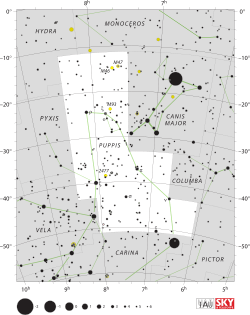Xi Puppis

| |
| Observation data Epoch J2000 Equinox J2000 | |
|---|---|
| Constellation | Puppis |
| Right ascension | 07h 49m 17.65567s[1] |
| Declination | −24° 51′ 35.2305″[1] |
| Apparent magnitude (V) | 3.35[2] |
| Characteristics | |
| Spectral type | G6 Iab-Ib[3] |
| U−B color index | +1.18[2] |
| B−V color index | +1.25[2] |
| Astrometry | |
| Radial velocity (Rv) | +2.7[4] km/s |
| Proper motion (μ) | RA: −4.81[1] mas/yr Dec.: −0.89[1] mas/yr |
| Parallax (π) | 2.72 ± 0.21[1] mas |
| Distance | 1,200 ± 90 ly (370 ± 30 pc) |
| Absolute magnitude (MV) | –4.73[5] |
| Details | |
| Mass | 9.9 ± 1.0[3] M☉ |
| Surface gravity (log g) | 1.21 ± 0.09[3] cgs |
| Temperature | 4,880 ± 150[3] K |
| Age | 23[3] Myr |
| Other designations | |
| Database references | |
| SIMBAD | data |
Xi Puppis (Xi Pup, ξ Puppis, ξ Pup) is a star in the southern constellation of Puppis. With an apparent visual magnitude of 3.35,[2] it is one of the brighter members of this constellation. It is a yellow supergiant. It is sometimes known as Asmidiske (Azmidiske), a misplacement and mistransliteration of Aspidiske, the traditional name of ι Carinae; hence the name Asmidiske for Xi Puppis is not currently IAU-approved.
Based on parallax measurements made during the Hipparcos mission, it is located approximately 1,200 light-years (370 parsecs) away, with a 7.5% margin of error.[1] Because of the distance of this star from the Earth, its visual magnitude is reduced by 0.73 as a result of extinction from the intervening gas and dust.[5]
Asmidiske has a 13th-magnitude companion at an apparent distance of 5".1. It might also be a spectroscopic binary.
References
- 1 2 3 4 5 6 van Leeuwen, F. (November 2007), "Validation of the new Hipparcos reduction", Astronomy and Astrophysics, 474 (2): 653–664, arXiv:0708.1752
 , Bibcode:2007A&A...474..653V, doi:10.1051/0004-6361:20078357
, Bibcode:2007A&A...474..653V, doi:10.1051/0004-6361:20078357 - 1 2 3 4 Johnson, H. L.; et al. (1966), "UBVRIJKL photometry of the bright stars", Communications of the Lunar and Planetary Laboratory, 4 (99): 99, Bibcode:1966CoLPL...4...99J
- 1 2 3 4 5 Lyubimkov, Leonid S.; et al. (February 2010), "Accurate fundamental parameters for A-, F- and G-type Supergiants in the solar neighbourhood", Monthly Notices of the Royal Astronomical Society, 402 (2): 1369–1379, arXiv:0911.1335
 , Bibcode:2010MNRAS.402.1369L, doi:10.1111/j.1365-2966.2009.15979.x
, Bibcode:2010MNRAS.402.1369L, doi:10.1111/j.1365-2966.2009.15979.x - ↑ Wilson, R. E. (1953). General Catalogue of Stellar Radial Velocities. Carnegie Institute of Washington D.C. Bibcode:1953GCRV..C......0W.
- 1 2 Luck, R. E. (May 1, 1982), "The chemical composition of late-type supergiants. IV - Homogeneous abundances and galactic metallicity trends", Astrophysical Journal, Part 1, 256: 177–188, Bibcode:1982ApJ...256..177L, doi:10.1086/159895